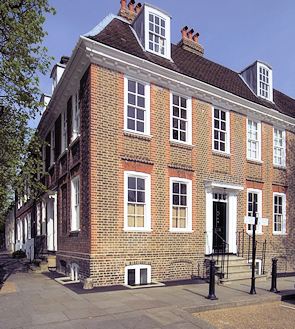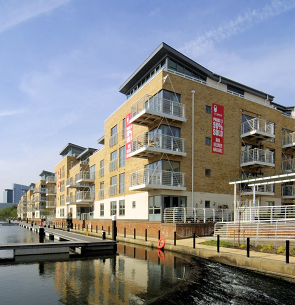Brentford
Brentford, Hounslow
A centre of industry and commerce since the Middle Ages, situated two miles west of Chiswick

The River Brent was named by the Celts, but it is not clear whether the original ford was a crossing of that river or the Thames. There is no direct evidence to support the legends that Julius Caesar crossed the Thames or fought a battle here in 54bc. The first genuine Battle of Brentford probably took place in the summer of 1016. This was one of a series of conflicts between English forces led by Edmund II and the Danes under King Canute. Edmund won the battle but lost the war.
With its good river and road connections, Brentford developed early as a trading place and was granted the right to hold markets and fairs in 1306. The construction of a new bridge across the Brent in 1446 contributed to the emergence of a settlement on the west bank known as Brentford End.
On the instructions of Henry VIII, part of the common land north of the High Street was commandeered for archery practice and by 1596 this area was known as the Butts.
Another Battle of Brentford took place on 12 November 1642, when Prince Rupert’s Royalists stormed and plundered the town. The severity of the pillage helped the Parliamentarians rally additional support at the Battle of Turnham Green on the following day.
Brentford grew in importance as a coaching stop and market town during the 17th century, with shops, inns, warehouses and dwellings, surrounded by orchards and market gardens. Middlesex county court sessions were held here and, later, parliamentary elections – leading to erroneous claims that it was the county town.
In the late 1680s the landlord of the Red Lion inn began to build houses at the Butts and these properties survive today as an unexpectedly glorious enclave. During the 19th century, industry expanded along the Old Brentford waterfront and the residential character of the town became increasingly working-class.
Brentford Football Club was founded in 1889 by members of the town’s rowing club who wanted to pursue a winter sport (a vote of eight to five decided it would be association rather than rugby football). The club moved to its present ground at Griffin Park in 1904.
By the early 20th century the High Street had become a bottleneck that was choking the free movement of traffic into London. Plans for a Brentford bypass were delayed by the First World War and then merged into a grander scheme to create a series of new approach roads to London.
The Great West Road opened in 1925, precipitating a new wave of industrial development. Brentford’s ‘golden mile’ of art deco factories, built by the likes of Smith’s crisps and Maclean’s toothpaste, prompted JB Priestley to liken a drive along the Great West Road to a vista of California.

Before and after the Second World War private builders spread streets of terraced houses across the remaining open land, while the borough council cleared slums and built flats and houses. On the Great West Road, the Firestone building was demolished in 1980 but the Beecham building survived a similar threat. The road has undergone a renaissance in recent years and several major companies have built new or redeveloped office complexes and made much-needed landscaping improvements, while residential schemes have included a new ‘waterside community’ at Brentford Lock (shown right).
The area’s visitor attractions include Watermans arts centre at 40 High Street, and the Musical Museum and the London Museum of Water & Steam at Kew Bridge.
Postcode area: Brentford TW8
Population: 14,353 (2011 census)
Station: South West Trains (zone 4)
Further reading: Gillian Clegg, Brentford Through Time, Amberley, 2011
and Carolyn and Peter Hammond, Brentford Then and Now, NPI, 2006
Website: BrentfordTW8.com
Selected Brentford extracts from Brewer’s Dictionary of London Phrase & Fable
[wpcol_1half id=”” class=”” style=“”]
As dirty as Old Brentford at Christmas
From early times, Brentford was one of the busiest market towns in Middlesex and notorious for its muddiness, which was at its worst in midwinter.
“The roads are consumed deep; I’m as dirty as Old Brentford at Christmas.” George Farquhar: The Beaux’ Stratagem, (1707)
A face like the Red Lion of Brentford
An old way of saying ‘a very red face’, perhaps one caused by years of heavy drinking. Given the popularity of that pub name it is uncertain why Brentford’s should have been chosen for this expression.
Pray, Sir, have you ever seen Brentford?
Dr Johnson’s response to Adam Smith after the Scottish economist had extolled the charms of Glasgow at some length; recorded in James Boswell’s Life of Samuel Johnson (1791).
[wpcol_1half_end id=”” class=”” style=“”][wpcol_1half id=”” class=”” style=“”][/wpcol_1half]
Like the two kings of Brentford
Formerly said of persons who were once rivals, but have become reconciled. The allusion is to Act II, scene ii of The Rehearsal (1672), by George Villiers, 2nd Duke of Buckingham, and others, in which the two kings of Brentford enter the stage hand in hand. The actors, to heighten the absurdity, used to portray them ‘smelling at one nosegay’. The play satirised The Conquest of Granada (1670), in which John Dryden eulogised the male bonding of two sovereigns. Buckingham clearly chose Brentford in deliberate contrast to the romance of Spain.
“And the two advocates, like the two kings of Brentford, march together, cheek-by-jowl, smelling at the same nosegay.” Jeremy Bentham: letter to Étienne Dumont (9 December 1825)
[wpcol_1half_end id=”” class=”” style=“”]
